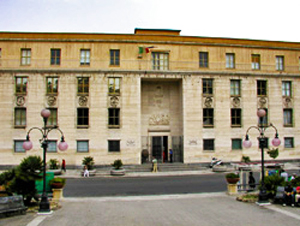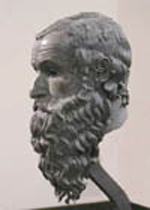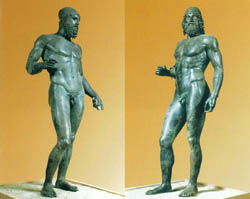Important cities of Sicily: Reggio calabria
 THE UNDERWATER ARCHAEOLOGY SECTION: This section of the museum was inaugurated in 1981 and dedicated to
the memory of the Museum Superintendent, Giuseppe Foti.
THE UNDERWATER ARCHAEOLOGY SECTION: This section of the museum was inaugurated in 1981 and dedicated to
the memory of the Museum Superintendent, Giuseppe Foti.
Collections of anchors, amphorae and finds from the ancient Greek wrek at Porticello, near Villa San Giovanni together with
the Philosopher’s Head, the Bronzes of Riace and other pertinent items.
On display on the walls of the stairway leading to this department are photographs of the recovery of two special wrecks.
One is the 4th century BC Greek ship discovered off Cyprus and the other is a Roman ship found in France at Madrague de Giens.
The collection of anchors shows the evolution in their design and manufacture starting with a stone with a hole in it that
could be tied with a rope and goes on to show other anchors made from a wooden shank with the anchor bill in bronze
and the stock in lead, of which only the stocks remain.
Some of the stocks on display are in stone and a few carry inscriptions; one of them, larger than the others bears the
letters “HPA”, perhaps since the ship was named after the deity.
The amphorae on display are of various types. Some are from the 4th 3rd century BC, others are slimmer and date from the
2nd century BC whereas others are from the Roman period ships and come from Tunisia.
The showcases display items found in 1969 on a wreck in the Bay of Porticello, slightly to the north of Villa San Giovanni,
at the beginning of the Straits of Messina. A wooden cup, a wooden bobbin used for fishing, a mortar, a jug,
pieces of a saucepan, two oil lamps, a number of painted 4th century BC Attic cups, and small vessels with narrow necks that
might have been inkwells, were recovered from this ship which was probably about 20 metres long.
There were numerous amphorae, some with a cone-shaped trunk and a long neck that were produced in Mende,
in the Aegean, some probably came from Mozia, while others were made in Magna Graecia.
In the next room there are fragments of a bronze statue which also came from the Porticello wreck.
However, most of the fragments (the right knee, parts of the clothing, the feet, the ankles, the right arm and the left hand)
belong to the head of the old man on display in the last room, known as “The Philosopher’s Head”.
THE PHILOSOPHER’S HEAD
 This is regarded by experts to be an actual portrait, and is considered to be the oldest know Greek portrait,
dating from the 5th century BC.
This is regarded by experts to be an actual portrait, and is considered to be the oldest know Greek portrait,
dating from the 5th century BC.
It was created with the utmost care to capture a perfect likeness, down to the tiniest details of the true facial
characteristic of the face portrayed in a period when Greek sculptors aimed at portraying people by idealising them rather
than really trying to achieve a true likeness.
THE HEAD OF BASEL
On display in the room of the Bronzes near the Head of the Philosopher, this exhibit comes from the same wreck of Porticello,
Villa San Giovanni, discovered in 1969.
Like the Head of the Philosopher, it most probably dates back to the 5th century BC and represents a warrior or a god.
It was not handed over to the Monuments and Fine Arts Service and was subsequently recovered, following the discovery of
the wreck, in Basel from where it obtained the name Head of Basel.
THE BRONZES OF RIACE
 The two bronzes were found by chance in 1972, on the seabed not far from the shore of the lonian seaside town of Riace,
about 120 kilometres from Reggio Calabria but the ship on which they were transported has never been found.
The two bronzes were found by chance in 1972, on the seabed not far from the shore of the lonian seaside town of Riace,
about 120 kilometres from Reggio Calabria but the ship on which they were transported has never been found.
It is likely that the two statues were being brought from Greece to Rome on board a ship that foundered in a storm.
The two masterpieces which are believed to date from the 5th century BC, have become famous throughout the world, both
because of the scarcity of bronze finds from this period and because of their perfect workmanship.
These two works of art are known as “Statue A”, referring to the one portraying a younger warrior and “Statue B” indicating
the more mature-looking of the two.
The restoration work began in the Reggio Calabria laboratories and continued at the Florence Restoration Centre.
The fusion of the statues was achieved using the “cire perdue” technique. There have been many attempts to identify
who they were made by and the most popular theory is that they were two separate Greek artist who lived in two different
periods about 30 years apart around the 5th century BC.
“Statue A” was probably cast between the years 460 and 450 BC and “Statue B” between 430 and 420 BC. Some believe
that “Statue A” was the work o Myron and that a pupil of Phydias, called Alkamenes wrought “Statue B”.
Statue A portrays a young hero or god, with an ineffable look, conscious of his own beauty and powerfulness.
Statue B on the other hand is of an older hero with relaxed limbs and a kinder, more gentle gaze.
The Museum faces piazza De Nava.




